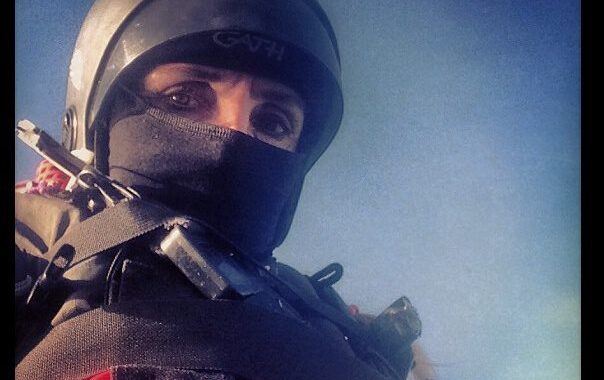N95 FACE RESPIRATORS AND WATER
FACE MASK RESPIRATORS AND WATER – IS IT SAFE?
N95 respirator ‘filtering’ face masks (FFRs) often are recommended and sometimes required for respiratory protection against infectious aerosol. There are various peer reviewed medical discussions and studies conducted on the use of respiration protection.
Recently we are observing a number of Rescue Water Craft (RWC or Personal Water Craft - PWC) recommendations for their use while underway, without reciprocal evidence to challenge the safety of this practice.
Likewise, there is significant controversy regarding one verifiable source that determines the who, what, when where and why with a contradictory reciprocal source. So, who is telling us the truth? Such as is the case with the current virus that came out of Wuhan, China in late 2019 and became known worldwide as COVID-19.
These on-water wearing measures did not make sense to me from a Watermanship experience. I decided to pull out a N95 mask and provide a simple, factual and effective demonstration on why I do not recommend my K38 Instructors to wear a face covering on the water while conducting Rescue Water Craft operations.
The 14 masks used in the test.
Neck fleeces, also called gaiter masks and often used by runners, were the least effective. In fact, wearing a fleece mask resulted in a higher number of respiratory droplets because the material seemed to break down larger droplets into smaller particles that are more easily carried away with air.
Folded bandanas and knitted masks also performed poorly and did not offer much protection.
"We were extremely surprised to find that the number of particles measured with the fleece actually exceeded the number of particles measured without wearing any mask," Fischer said. "We want to emphasize that we really encourage people to wear masks, but we want them to wear masks that actually work."
EVIDENCE BASED
I have thousands and thousands of de novo hours working on the water in every type of weather condition and all waterway levels around the world; day and night. In fact, more than any human on Earth at this time. I have worn balaclavas since the early 1990’s. Due to inclement weather while working in extreme water conditions to cold or high wind conditions. Balaclavas have limitations and are a compliment to the risk environment we operate in.
The use of a balaclava has assisted me with the reduction of wind chill effects. Everyone who has seriously worked a Rescue Water Craft boat knows the effect is not a sunburn, but wind burn on the face of exposed skin. Hence the entry use of the full face and neck covering referred to as ‘balaclava’. Not to be confused with the utterly delicious baklava.
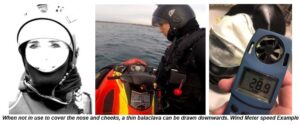
There are concerns however. These balaclavas are best used not to of thick material made of felt or similar. The water saturation levels can be significant. My experience after buying over 60 of these for testing, and different uses in the water have taught me that the thinnest material is the best. And why is that you ask?
BREATHING!
Oxygen reduction when placed under physical exertion is a reality wearing one of these face shields. We use a full head covering that covers the entire length of the neck and leaves an opening for goggles.
Operating a Rescue Water Craft is considered an ‘active ride’. Also, the compliment of eye protection equally assists in preventing loss of vision or injury. The fogging effect of goggles is a second discussion to be concerned about. Balaclava breathing holes help, but that would defeat the purpose of airborne particle dispersion.
FOGGED
How many people have you heard complain who are shopping and wearing masks for the first time stating that their glasses are fogging up? Yup. There it is.
I learned the limitations of covering my nasal and oral passages under exertion, at speed, with gale force winds, serious temperature changes and intense painful rainfall. The experience of having a box of nails thrown at my face (your face) traveling at 35 miles per hour with 30 knots of wind is not a pleasant experience.
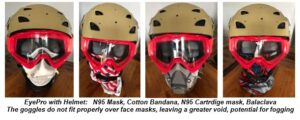
A Balaclava is a huge help, however breathing patterns are more strained. If working in a saltwater environment the concentration of salt will build up over hours; a corrosive influence against skin or lip contact.
Our body fights back and increases drainage, specifically the faucet starts to run on snot and mucus that our bodies create from struggling to maintain optimum balance against these environmental balances. Operating a Rescue Water Craft is not a dry experience. It is a ‘wet and saturated ride’. That is why Coxswains and crew wear specific water Personal Protective Equipment (PPE) and not dry garments or uniforms. This is due to ‘exposure’.
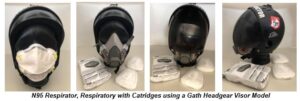
Operating through surf is considered ‘high to extreme risk’ due to the fact that a hard-hulled power boat can capsize. The Man Over Board (MOB) potential is a true reality. These extreme operating zones required proper vetting of both the crew and the equipment used, including PPE. Keep It Simple Stupid, KISS is a good rule.
Navigating inside the surf zone eventually will determine the Coxswain must operate the craft up over wave after wave of varying intensity and height. This creates an overall splash down effect of the exterior of the craft, TAD (Towable Aquaplane Device aka rescue board) and those on board. N95 respirator masks will not make it out here. Some balaclavas may become a hinderance instead of an advantage. Bandanas are loosely fitting and have air flow voids; helmets may not fit properly and cause the helmet to ride forward towards the eyebrows.
This 'wet down' behavior applies to certain fetch, angle and steepness of swell or river class of navigation. Wind can also whip up spray, and the vessel itself can create a ‘spray curtain’ depending upon the Coxswain ability and navigating determination.
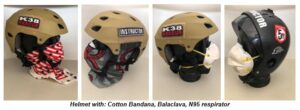
Qualified Coxswains and Crew wear full water rescue PPE, this means full finger water gloves. These gloves are also saturated. They must wear a water style helmet. The helmet can collect and drain water along with gloves.
How much water is held within saturated gloves? How much in a saturated face mask?
To be a qualified professional Rescue Water Craft Coxswain is a heady responsibility. One must multi task on multiple operational levels while underway. Psolar.BX Balaclava is one of interest but I have not tested this product yet. Typically, Balaclavas are for heat exchange for facial exposure, primarily used in snowmobile, bikes, motorcycles and any fast-moving activity against the exposure of wind chill, burn, rain or snow. But rarely water.
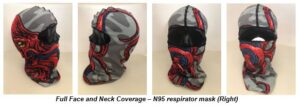
A fouled mask that causes an effect similar to reduced oxygen flow and the potential for inhalation of water is a thousand MEME dream come true. I can’t breathe! Because it is probably true.
BE A THINKING RWC COXSWAIN
Let’s ask a stupid question: How is a respirator mask or face covering going to protect crew who operates on a vessel that is at the water line and maintain the efficacy of the rule of safety for ‘face masks, with wet gloves, wet helmet and wet PPE?
Undeniable we will get either jackass comments or realistic professional responses. There is only one answer.
It is impossible and improbable. But it does allow people to pretend they are doing something, even if its wrong.
So why are Rescue Water Craft personnel rushing to jump on the silly train? Where is their evidence and justification? Where is their safety argument? I offer you my professional evaluation, and encourage your own.

TO MASK OR NOT TO MASK
The decision to not wear a qualified type and proper fit for a N95 respirator that prevents COVID-19 droplet contact while working with a Rescue Water Craft at the shores edge or on the water during training or operations is based upon thousands of hours of evidence-based practical and real-world experience.
N95 rated masks are considered respirators due to their ability to filter 95% of particles in the environment using static electricity. Let me stress that is a ‘dry’ environment.
These masks in the USA are tested and approved by the National Institute for Occupational safety and Health referred to as NIOSH. Each fit must be ergonomic to facial shape to ensure a snug and tight fit.
Rescue Water Craft Coxswains are being asked in an occupational field to be compliant. However, there is no solution for working on, in or over the water with a proper respirator while underway in active environments.
These masks must be properly and tightly fitted with minimal leakage to be effective. Not gonna happen.
What if you are asthmatic? The World Health Organization described asthma as a common lung condition that causes sporadic breathing difficulties. Adding that its strongest risk factors are inhaled substances and particles that may provoke allergic reactions or irritate the airways.
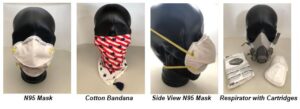
NOT ON OUR UNDERWAY WATCH
The Centers for Disease Control (CDC) clearly explain the medical health risk justification for not wearing a face mask while working; on, in or contact with the water due to risk of personal and team safety.
This could cause a serious accident, injury, loss of the vessel, damage to the equipment or in extreme cases due to location; death.
• People should not wear cloth face coverings while engaged in activities that may cause the cloth face covering to become wet, like when swimming at the beach or pool. A wet cloth face covering may make it difficult to breathe. For activities like swimming, it is particularly important to maintain physical distance from others when in the water.
• People who are engaged in high intensity activities, like running, may not be able to wear a cloth face covering if it causes difficulty breathing. If unable to wear a cloth face covering, consider conducting the activity in a location with greater ventilation and air exchange (for instance, outdoors versus indoors) and where it is possible to maintain physical distance from others.
• People who work in a setting where cloth face coverings may increase the risk of heat-related illness or cause safety concerns due to introduction of a hazard (for instance, straps getting caught in machinery) may consult with an occupational safety and health professional to determine the appropriate face covering for their setting. Outdoor workers may prioritize use of cloth face coverings when in close contact with other people, like during group travel or shift meetings, and remove face coverings when social distancing is possible.
Water penetration is significant with wearing any of the following covering the airway (nasal/oral) while underway:
1. Folded Cotton Bandana
2. Thin Fabric Balaclava
3. N95 Respirator Mask
Or a combination thereof. This also forces a safety problem for Coxswain and Crew eye protection (Eyebrow) causing the interior of the lends to fog up at a faster rate.
This is a serious safety problem for underway operations. Vapor steaming the interior of the lens during normal operations is a concern and greatly enhances with additional temperature changes and physical exertion breathing patterns. Goggles are used with a close-fitting seal against the face.
Helmets structure can alter this fit and adding any additional layers below the frame alter the safe use of goggles inherent use protocols.
WHERE IS THE ANSWER?
The Centers for Disease Control (CDC) states the following emphasizing the words MAY, MOST LIKELY:
• ‘Cloth face coverings may help prevent people who have COVID-19 from spreading the virus to others. Cloth face coverings are most likely to reduce the spread of COVID-19 when they are widely used by people in public settings
• Cloth face coverings should NOT be worn by children under the age of 2 or anyone who has trouble breathing, is unconscious, incapacitated, or otherwise unable to remove the mask without assistance
• Cloth face coverings are recommended as a simple barrier to help prevent respiratory droplets from traveling into the air and onto other people when the person wearing the cloth face covering coughs, sneezes, talks, or raises their voice. This is called source control
• The cloth face cover is meant to protect other people in case you are infected.
Cloth face coverings should not be worn by:
• Children younger than 2 years old
• Anyone who has trouble breathing
• Anyone who is unconscious, incapacitated, or otherwise unable to remove the cloth face covering without assistance
• In some situations, wearing a cloth face covering may exacerbate a physical or mental health condition, lead to a medical emergency, or introduce significant safety concerns. Adaptations and alternatives should be considered whenever possible to increase the feasibility of wearing a cloth face covering or to reduce the risk of COVID-19 spreading if it is not possible to wear one.
Surgical Masks
CDC: ‘Cloth face coverings are not surgical masks or respirators. Currently, those are critical supplies that should continue to be reserved for healthcare workers and other medical first responders, as recommended by current CDC guidance. Cloth face coverings also are not appropriate substitutes for them in workplaces where masks or respirators are recommended or required and available.’
Testing the Efficacy of Homemade Masks: Would They Protect in an Influenza Pandemic?
Objective: This study examined homemade masks as an alternative to commercial face masks.
Methods: Several household materials were evaluated for the capacity to block bacterial and viral aerosols. Twenty-one healthy volunteers made their own face masks from cotton t-shirts; the masks were then tested for fit. The number of microorganisms isolated from coughs of healthy volunteers wearing their homemade mask, a surgical mask, or no mask was compared using several air-sampling techniques.
Results: The median-fit factor of the homemade masks was one-half that of the surgical masks. Both masks significantly reduced the number of microorganisms expelled by volunteers, although the surgical mask was 3 times more effective in blocking transmission than the homemade mask.
Conclusion: Our findings suggest that a homemade mask should only be considered as a last resort to prevent droplet transmission from infected individuals, but it would be better than no protection.
https://pubmed.ncbi.nlm.nih.gov/24229526/
Wet PPE, N95 masks
Employees of the government-run ambulance service provider 108 complained that personal protective equipment is difficult to work in as it gets soaked, and it is difficult to breathe through wet N95 masks. N-95 masks, which are made of non-woven polypropylene fabric, are not waterproof. Once wet, they are difficult to breathe through.
“We don’t get waterproof face shields so when the mask gets wet, we have no option but to remove it and wear a new one once inside,” said another ambulance worker from 108. This means the ambulance workers expose themselves to infection in a contaminated area while changing masks.
RESOURCES FOR REVIEW
Understanding the Differences infographic:
https://www.cdc.gov/niosh/npptl/images/100years/UnderstandDifference3.jpg
As well as providing this guidance to the public, the Yolo County Health Department is also advising the cautious use of N95 respirators for the following reasons:
• N95 respirators can make it more difficult for the wearer to breathe due to carbon dioxide build up, which reduces the intake of oxygen, increased breathing rates and heart rates.
• People with chronic respiratory, cardiac or other medical conditions that make breathing difficulty should check with their healthcare provider before using an N95 respirator.
• To work as expected, an N95 respirator requires a proper fit to your face.
• The Centers for Disease Control and Prevention (CDC) does not generally recommend facemasks and respirators for use in home or community settings.
• N95 use may lead to increased heart rate, respiratory rate, work of breathing, carbon dioxide buildup in micro-ambient air and heat stress -- potentially posing risk to sensitive populations.
• Use of masks may encourage outdoor activity which could worsen exposure.
• N95 masks are not recommended for children due to the impact on breathing.
Please follow the above recommended actions to stay healthy and safe. For more information regarding air quality and public health in Yolo, visit: www.ysaqmd.org.
Study of the micro-climate and bacterial distribution in the dead space of N95 filtering face respirators
During inhalation, the temperature of the core region decreases gradually until the end of the breath cycle.
Meanwhile, the temperature of the core region is slightly higher than that of the surrounding region because the core region is closer to the nostrils. Overall, the temperature of dead space is approximately 6 K higher than the ambient temperature of 296.25 K.
Figure 5 shows the cross-sectional view of the water vapor volume fraction in the upper respiratory system during the 101st breath cycle. It can be found that the water vapor volume fraction around the FFR rises rapidly during exhalation, and the largest concentration of water vapor occurs at the core region at 483.0 s (end of exhalation). It is apparent that the concentration of water vapor decreases during inhalation.
https://www.nature.com/articles/s41598-018-35693-w
Physiological Impact of the N95 Filtering Facepiece Respirator on Healthcare Workers
Conclusions: In healthy healthcare workers, FFR did not impose any important physiological burden during 1 hour of use, at realistic clinical work rates, but the FFR dead-space carbon dioxide and oxygen levels were significantly above and below, respectively, the ambient workplace standards, and elevated P (CO2) is a possibility. Exhalation valve did not significantly ameliorate the FFR's P (CO2) impact.
https://pubmed.ncbi.nlm.nih.gov/20420727/
NIOSH routinely makes recommendations regarding the use of respirators for workers exposed to environments that contain hazardous concentrations of airborne contaminants or oxygen-deficient atmospheres. This document provides industrial hygienists and other professionals knowledgeable in respirator selection with a procedure for selecting suitable classes of respirators for particular concentrations of specific contaminants.
https://www.cdc.gov/niosh/docs/87-108/pdfs/87-108.pdf?id=10.26616/NIOSHPUB87108
N95 Filtering Facepiece Respirator Dead space Temperature and Humidity
The objective of this study was to determine the levels of heat and humidity that develop within the dead space of N95 filtering facepiece respirators (N95 FFR).
FFR mean moisture retention was < 0.3 grams over 2 hr. N95 FFR/EV offer a significant advantage in dead space heat dissipation over N95 FFR at a low-moderate work rate over 1 hr. of continuous use but offered no additional benefit in humidity amelioration. Moisture retention in N95 FFR and N95 FFR/EV is minimal after 2 hr. of use. [Supplementary materials are available for this article. Go to the publisher's online edition of Journal of Occupational and Environmental Hygiene for the following free supplemental resource: a file containing N95 filtering facepiece respirator dead space mean RH and temperature recordings for 17 subject’s treadmill exercising at 5.6 Km/H over 1 hour.]. https://pubmed.ncbi.nlm.nih.gov/22413894/
Americans with Disabilities Act determined that you are not required if you fall under ADA categories to disclose your medical condition to anyone regarding ‘not wearing a face covering or mask’.
IN CLOSING
Continue your own research. Reach out to Subject Matter Experts. Open the #WARESed diaglogue. Don't follow untested methods without engaging in research, study and dialogue. This is good advice to all our fellow water safety partners. Tread lightly or don't tread at all, or you may sink.
And Balaclavas are great! Ask me how I know?
Faithfully yours,
Shawn
__________
Posted: July 9, 2020
Content Creator of Rescue Water Craft and Personal Water Craft boating international education standards: Shawn is the world’s foremost authority and leading subject matter expert. She cares most about her community and the culture surrounding the safety of event service providers and Rescue Water Craft operators, working hard and dedicated towards protecting their reputation, distributing safety information and continuing to train these amazing individuals to the highest standards of care.
__________
Have any questions? Come train with us and discover what your community is doing to modernize standards, safety and reduce liability!
Caution: Visit page terms and conditions. Use at your own risk. Please take a qualified Rescue Water Craft training course and maintain proper records and respect all the PWC, RWC, PPE, and gear OEM manufacturer warning labels and cautions.
K38 Website PDF disclaimer
Caution Disclaimer:
Use at your own risk. Please take a qualified Rescue Water Craft training course and maintain proper records and respect all the PWC, RWC, PPE, gear and OEM manufacturer warning labels, uses and cautions. Read our page disclaimers and terms and agree to them.
Abide by all the Federal, State and Local boating rules and regulations, take a safe boating course.
The content posted on this site is not a training aid and should not be used as such.
Terms of Use for downloads or viewing
1. You are granted the right to download the eBook
2. You may print pages of the eBook for your personal use and reference
3. You further agree not to translate, decompile, or disassemble the eBook
4. You agree to protect the eBook for unauthorized use, reproduction or distribution
5. The entire contents of the eBook are protected by copyright, you may not remove, delete, transmit or create derivative works from the eBook content. No part of the eBook may be transmitted in any form by any means or reproduced for any other purpose, without the prior written permission by the author.
6. Disclaimer: The eBook is provided ‘as is’, without warranty of any kind, expressed or implied including without limitations, accuracy, omissions, completeness or implied warranties or suitability or fitness for a particular purpose or other incidental damages arising out of the use or the inability to use the eBook.
You acknowledge that the use of this service is entirely at your own risk. This agreement is governed by USA law.
You acknowledge that you have read this Agreement and agree to be bound by its terms and conditions.
Third party website links mentioned in any posts do not endorse the content of this eBook or website material.
Use at your own risk. Abide by all applicable boating rules, laws and regulations.
Your use of the Service is at your sole risk. Read and agree to the terms and conditions and privacy policy of this site. Reference the author and document if content is used when permission is granted.
